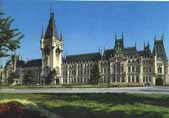During the 13th century, Dutch navigators brought from China the first
sets of bells grouped according to tones and controled by pin reels.
The oldest automaton made in Europe which uses a system of bells controled
by a pin reel is the carillon of the Cathedral in Strasbourg (1352-1354).
Among the famous carillons, mention should be made of those in: Dunkerque
(1437), Alost in Belgium (1487) and Anveres (1540) with a system of
60 bells.
In 1925, engineer Horia Pascalovici installed a carillon with 8 bells
in the tower of the Palace of Culture. The device plays every sharp
hour the song "Hora Unirii" (The Romanian Round Dance of
the Union).
The oldest
cylinder organ, named Bull of Salzburg was made in 1502. The German
monk Athanasius Kicher published in 1650 a document about the church
organ functioning with a pin reel. At that epoch, music automata were
largely appreciated at the European courts. In France Jaques de Vaucanson
(1709-1772), Pierre Jaquet – Droz (1721-1780) obtain excellent
results with their androides.
At the beginning
of the 17th century, in Mirecourt, France, miniature organs started
being produced, while later was developed a considerable industry
of organs of various types. The crank organs were more and more used
in the streets by travelling singers, cripples, merchants and Savoyards.
The museum
collection includes an automatic organ with 84 tubes, particularly
valuable, made in Vienna at about 1850. It has 4 cylinders, which
contain a single melody each:
1 - National
Marche-Rum
2 - Arie din
opera Don Pasquale, Donizetti
3 - Ceardas
4 - Hori nationale
–Rum.
Kopecky street organ was made in 1936 by the company J. Kopecky in
Timisoara. It is a 17 pipe-organ, with 1 cylinder with 9 melodies.
Other music
automata which use as a recording support the pin reel are the music
boxes. They were invented in 1796 by the Swiss Antoine Favre (1734
-1820). The mechanism is simple: the pins of the cylinder determine
the vibration of the teeth of a metallic comb. The reel is turned
slowly by an arch engine, the rotation being controlled by a paletted
giration regulator. At the beginning, the small size mechanisms were
introduced in pieces of jewelry, horloges and other objects. Then,
the cylinder becomes bigger, the music devices more refined so that
a real industry of music boxes develops in Switzerland. At the end
of the 19th century were designed music boxes which apart the normal
mechanism also contained an organ mechanism named "heavenly voices".
The mechanicaal
pianos with pin reels, used indoors or outdoors, are instruments with
strings which in Romania are known as mechanical cembalo. The most
frequent were the Spanish street pianos, quite often made by Italians.
In Romania were acknowledged mechanical cembalos made by Giussepe
Turconi of Constantinople.
In 1804, in
Vienna, J.N. Mälzel made the first orchestron named "Panharmonicum”.
Ludwig van Beethoven composed for this instrument the melodies: The
Victory of Wellington and The Battle of Vitoria. Orchestrons are automatic
devices designed for public spaces, which produce music similar to
that of orchestras. The museum collection includes six orchestrons
controlled by pin reels and bridges. The "Valsonora” orchestron
was made in Germany at the end of the 19th century. A plate fixed
on the furnishing reads: "At Inger's: music shop, sewing machines,
gramophones, various furniture items, guns, money cases. Jaques Calmanovici
Iasi”.

